Dell 2707WFP: Looking for the Middle Ground of Large LCDs
by Jarred Walton on April 4, 2007 10:00 AM EST- Posted in
- Displays
Appearance and Design
If you've seen/used any of Dell's other LCDs, the difference in appearance and styling of the 2707WFP is immediately noticeable. Gone are the black bezels and silver base stand. In their place we have a brushed aluminum bezel, a base stand with a black mirror finish, and various chrome highlights. Opinions on aesthetics will vary by individual, but we certainly like the new styling of this LCD.
Like the 2407WFP, the bottom right corner on the front of the LCD has six buttons. The left button switches among the various input options, and the next button controls the picture-in-picture settings. The middle button accesses the on-screen display (OSD) and also functions as the select button within the OSD. The next two buttons are for left/up/decrease and right/down/increase, and on the far right is the power button. The power button also glows blue when the LCD is on or orange when the display is in sleep mode. To the left of the six buttons are five LEDs that indicate the active input, although these LEDs only light up during the input select process and are otherwise off.
The rear of display continues the silver brushed aluminum finish, with black ventilation areas on the sides and top. You can also get a better view of the base stand here, and the highly reflective finish is obvious. Fingerprints can be a problem, but Dell conveniently includes a nice nonabrasive cloth to help keep things clean. Unlike many other LCDs, the 2707WFP comes fully assembled. If you want to remove the base stand, you'll have to remove the four T10 Torx screws, at which point you can access the standard VESA wall mount.
Above is a shot of the rear of the unit without the base stand installed. The lower image shows the input ports, as well as two of the extra USB ports. To the right of power socket you can see a power connector for the optional AS501 speaker bar attachment. It's the same model as the 2407WFP uses, although it's interesting that the 2407WFP specifically lists speaker accessories during the configuration process while the 2707WFP does not. That's an oversight of the configurator that could use correcting, although for Dell PCs this is not an issue.
Here you can see the left side of the panel with the flash memory readers and the other two USB ports. You can also see the tilt mechanism in full swing, ranging from a 5° forward tilt to a 30° backwards tilt. The mounting arm of the base stand is quite a bit different than other Dell LCDs, apparently going for something of a "chrome robot" theme. [Ed: Someone actually mentioned Robocop during the course of our evaluation.] However, while the base stand looks different from most other LCDs, it still functions quite well.
The base stand also helps with minimizing cable clutter by providing for cable routing. A black plastic cover can be removed from the mounting arm, and then you can feed the various cables that you plan on using through the slot in the base stand. After that's done, simply slide the black cover back into place. You'll want to provide a bit of slack on the cables, but as a whole the cable routing works quite well.
If you've seen/used any of Dell's other LCDs, the difference in appearance and styling of the 2707WFP is immediately noticeable. Gone are the black bezels and silver base stand. In their place we have a brushed aluminum bezel, a base stand with a black mirror finish, and various chrome highlights. Opinions on aesthetics will vary by individual, but we certainly like the new styling of this LCD.
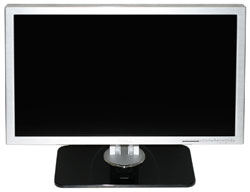 |
 |
| Click to enlarge | |
Like the 2407WFP, the bottom right corner on the front of the LCD has six buttons. The left button switches among the various input options, and the next button controls the picture-in-picture settings. The middle button accesses the on-screen display (OSD) and also functions as the select button within the OSD. The next two buttons are for left/up/decrease and right/down/increase, and on the far right is the power button. The power button also glows blue when the LCD is on or orange when the display is in sleep mode. To the left of the six buttons are five LEDs that indicate the active input, although these LEDs only light up during the input select process and are otherwise off.
 |
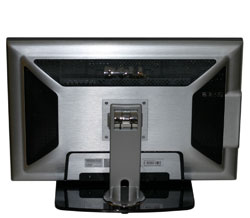 |
| Click to enlarge | |
The rear of display continues the silver brushed aluminum finish, with black ventilation areas on the sides and top. You can also get a better view of the base stand here, and the highly reflective finish is obvious. Fingerprints can be a problem, but Dell conveniently includes a nice nonabrasive cloth to help keep things clean. Unlike many other LCDs, the 2707WFP comes fully assembled. If you want to remove the base stand, you'll have to remove the four T10 Torx screws, at which point you can access the standard VESA wall mount.
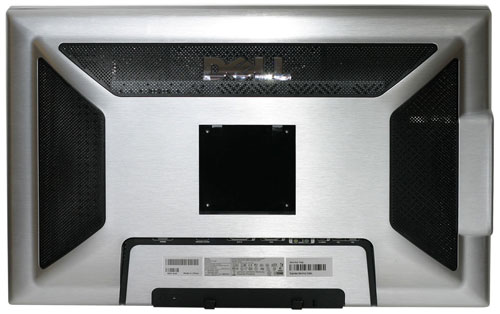 |
 |
| Click to enlarge |
Above is a shot of the rear of the unit without the base stand installed. The lower image shows the input ports, as well as two of the extra USB ports. To the right of power socket you can see a power connector for the optional AS501 speaker bar attachment. It's the same model as the 2407WFP uses, although it's interesting that the 2407WFP specifically lists speaker accessories during the configuration process while the 2707WFP does not. That's an oversight of the configurator that could use correcting, although for Dell PCs this is not an issue.
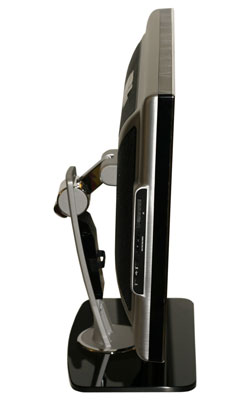 |
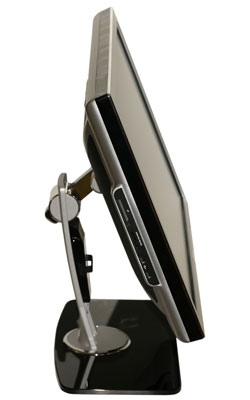 |
| Click to enlarge | |
Here you can see the left side of the panel with the flash memory readers and the other two USB ports. You can also see the tilt mechanism in full swing, ranging from a 5° forward tilt to a 30° backwards tilt. The mounting arm of the base stand is quite a bit different than other Dell LCDs, apparently going for something of a "chrome robot" theme. [Ed: Someone actually mentioned Robocop during the course of our evaluation.] However, while the base stand looks different from most other LCDs, it still functions quite well.
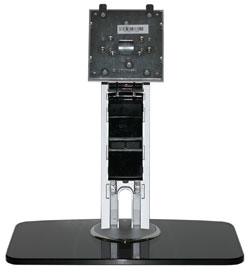 |
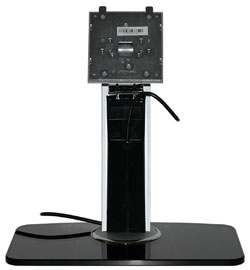 |
| Click to enlarge | |
The base stand also helps with minimizing cable clutter by providing for cable routing. A black plastic cover can be removed from the mounting arm, and then you can feed the various cables that you plan on using through the slot in the base stand. After that's done, simply slide the black cover back into place. You'll want to provide a bit of slack on the cables, but as a whole the cable routing works quite well.










39 Comments
View All Comments
JarredWalton - Wednesday, April 4, 2007 - link
A perfect example of stuff that doesn't look right with a higher DPI setting is anything that uses a bitmap. All of the icons at 120dpi tend to look like crud in XP. There are just far too many areas of Windows and the applications that run on it that are built around pixel sizes, so changing DPI settings only sort of affects them.Anyway, the point isn't whether or not higher DPI is good or bad. You like it, others don't. That's the main idea behind that introduction: an explanation of why higher pixel pitch can be a good thing. I really do have poor vision (an irregular astigmatism that can't be corrected without a retina transplant, so I live with slight double vision). I find many of the high DPI screens to be undesirable, although I do like higher resolutions for image work.
kalrith - Wednesday, April 4, 2007 - link
Since we're discussing pixel pitch and poor eyesight, I thought I'd mention that one of my coworkers has such poor vision that he's using a 21" LCD at 800x600 resolution and thinks it's "just right".Also, out of the 10 19" LCDs we have, only one person runs hers at the native res. Everyone else uses 1024x768.
LoneWolf15 - Thursday, April 5, 2007 - link
This is one reason why I "downgraded" (the rest of the specs are similar, other than that I also shaved 2 pounds of weight) from a laptop with a 15" 1600x1200 UXGA display to a 14" 1024x768 XGA display. At 15", picture detail was incredible, but text for web browsing was giving me sore eyes and headaches. I wouldn't mind having 1280x1024 at 14" or 15", but since I'm not paying for it, beggars can't be choosers.It's also why I returned my Dell 2007WFP and exchanged it for a 2407WFP. Higher resolution, but larger pixel pitch as well.
kmmatney - Wednesday, April 4, 2007 - link
I'm another person who likes big pixels. Work tried to give me a 17" LCD, but I would have none of that. I then tried a 21" Samsung at 1600 x 1200, but it was still too small. Now I have a 20" LCD running native at 1400 x 1050 and its really nice. I have a laptop with small pixels that I use when I travel, but I'm much more productive when I can see everything clearly.I would love to have this display, but it really needs to come down in price.
strikeback03 - Wednesday, April 4, 2007 - link
my vision is awful uncorrected - way beyond not being able to see the big "E". But since I'm always wearing glasses or contacts anyway I like high-DPI displays. Love my thinkpad with the SXGA 15" display. The UXGA 15" would probably be hard to read though.My boss has a ~20" CRT that he runs at either 800x600 or 1024x768.
jc44 - Wednesday, April 4, 2007 - link
OK - I admit it - I'm stunned. With the exception of your colleague with the poor eyesight I find it hard to conceive how anyone would prefer (presumably) a slightly fuzzy (due to scaling artifacts) 1024x768 to a sharp 1280x1024 on a 19" LCD. I could simply not put enough information on the screen to be able to do my job at that resolution without resorting to a lot of printouts.Well horses for courses I guess - thanks
JC
xsilver - Friday, April 6, 2007 - link
lol - the amount of people that have their lcd monitors set to non native resolutions is insanely funny.but even more insanely funny is how many people say they cant see anything wrong with the scaling artifacts and fuzziness.
I haven't done much (any) testing on this in gaming though - is the distortion just as bad in gaming when running a non native res? getting a 20" lcd or above these days has pretty much required a high end graphics card to be purchased if any gaming wants to be done if you want to run native res.
still prefer crt atm myself but I realize it will be inevitable that i'll have to make the switch and need to figure out some options.
mitchell123 - Thursday, December 3, 2009 - link
hello FriendsThios is a nice article.......for everyone...........
==============
Mitchell
Tommyguns - Wednesday, April 4, 2007 - link
19" Viewsonic lcd here. you guessed it. 1024x768 and it suits me just fine. not that i have bad eyes at age 22 or anything, i just like being able to clearly see everything. I game hard as well and it works out just fine. i do have it in clone mode going to an aux 17inch crt thats about 20 feet away. higher res. is nice, but i prefer big letters, with out the squints sometimes.it would be nice to know what is around average in terms of gpu's, to be able to use these larger lcd's. average wasnt always a super highend 8xxx series card.